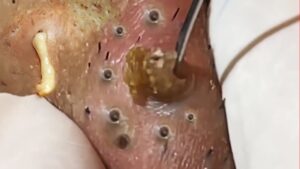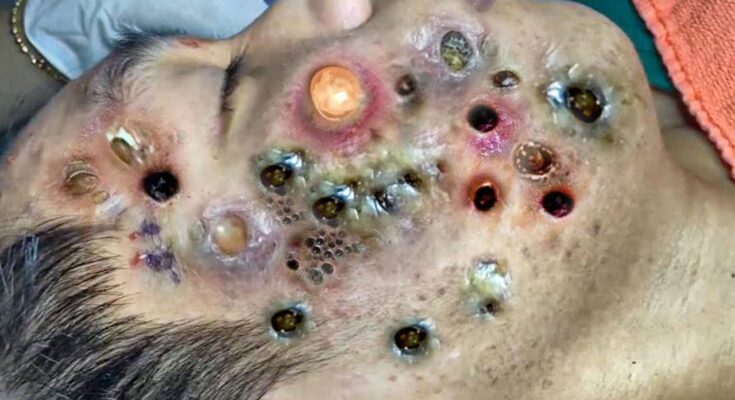Blackheads, a common skin issue, can be frustrating to deal with. They form when hair follicles become clogged with dead skin cells, oil, and bacteria. While they aren’t usually painful or dangerous, they can be unsightly and lead to self-consciousness. If you’re dealing with a significant number of blackheads on your face, here’s a comprehensive guide on how to address them effectively:
Understanding Blackheads
Blackheads are a type of acne known as open comedowns. They appear as small, dark spots on the skin’s surface due to oxidation. This happens when the trapped material in the hair follicle reacts with oxygen in the air, turning black. Common areas for blackheads include the nose, chin, and forehead, but they can appear anywhere on the face.
Causes of Blackheads
Several factors contribute to the formation of blackheads:
- Excess Oil Production: Overactive sebaceous glands can produce too much oil, leading to clogged pores.
- Hormonal Changes: Fluctuations in hormones, especially during puberty, menstruation, or pregnancy, can increase oil production.
- Improper Skin Care: Not cleansing the skin properly can allow dirt and oil to accumulate, clogging pores.
- Diet: High consumption of dairy products and sugary foods might exacerbate acne, though this varies from person to person.
- Cosmetic Products: Using comedogenic makeup or skincare products can block pores.
- Sweating and Humidity: Excessive sweating and high humidity can contribute to blackhead formation.
Steps to Address Blackheads
- Cleansing Routine:
- Use a Gentle Cleanser: Cleanse your face twice daily with a gentle, non-comedogenic cleanser to remove dirt, oil, and makeup. Avoid harsh scrubs that can irritate the skin.
- Double Cleansing: Consider double cleansing, especially if you wear makeup. Start with an oil-based cleanser to dissolve makeup and sunscreen, followed by a water-based cleanser to remove impurities.
- Exfoliation:
- Chemical Exfoliants: Use products containing salicylic acid or glycolic acid. Salicylic acid penetrates and cleans out pores, while glycolic acid exfoliates the skin’s surface, promoting cell turnover.
- Physical Exfoliants: If you prefer physical exfoliation, choose gentle exfoliants with fine particles. Use them sparingly to avoid over-exfoliating, which can irritate the skin.
- Pore Strips and Masks:
- Pore Strips: These can provide a quick fix by removing the top layer of blackheads. However, they don’t prevent blackheads from returning and can sometimes irritate the skin.
- Clay Masks: Clay masks, especially those containing bentonite or kaolin, can help absorb excess oil and draw out impurities from the pores.
- Topical Treatments:
- Retinoids: Over-the-counter retinoids (like adapalene) or prescription retinoids (like tretinoin) can help prevent clogged pores and promote cell turnover.
- Benzoyl Peroxide: This can kill bacteria and reduce inflammation. Use it in conjunction with other treatments for best results.
- Moisturizing:
- Non-Comedogenic Moisturizers: Keep your skin hydrated with a lightweight, oil-free moisturizer to prevent it from overproducing oil.
- Sun Protection:
- Sunscreen: Use a non-comedogenic, broad-spectrum sunscreen daily. Sun damage can worsen acne and lead to hyperpigmentation.
- Professional Treatments:
- Facials: Professional facials can include extractions performed by a licensed esthetician, which can safely remove blackheads.
- Chemical Peels: These treatments involve applying a chemical solution to exfoliate the skin deeply and improve its texture.
- Microdermabrasion: This minimally invasive procedure uses a special applicator with an abrasive surface to gently sand away the thick outer layer of the skin.
- Laser and Light Therapy: These treatments can reduce oil production and bacteria, helping to clear blackheads and prevent future breakouts.

Lifestyle Adjustments
- Healthy Diet:
- Balanced Diet: Eat a diet rich in fruits, vegetables, lean proteins, and whole grains. Some studies suggest that a low-glycemic diet may help reduce acne.
- Hydration: Drink plenty of water to keep your skin hydrated and help flush out toxins.
- Hygiene Practices:
- Avoid Touching Your Face: Minimize touching your face to prevent the transfer of dirt and bacteria.
- Clean Pillowcases: Change your pillowcases regularly to reduce the accumulation of oil and bacteria.
- Stress Management:
- Stress Reduction Techniques: Practice stress-reducing activities like yoga, meditation, or regular exercise. Stress can trigger hormonal changes that exacerbate acne.
When to See a Dermatologist
If over-the-counter treatments and home care don’t improve your blackheads, it may be time to see a dermatologist. A dermatologist can provide personalized treatment options and may prescribe stronger medications or recommend advanced procedures.
Summary
Dealing with a significant number of blackheads can be challenging, but with a consistent skincare routine and the right treatments, you can significantly reduce their appearance. Start with a gentle cleanser, incorporate exfoliation, use targeted treatments, and maintain a healthy lifestyle. If necessary, seek professional help for more stubborn cases. With patience and persistence, you can achieve clearer, healthier skin.
https://www.youtube.com/watch?v=lqNu_fQFUbU&pp=ygUOcGltcGxlIHBvcHBpbmc%3D
